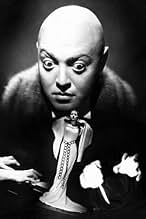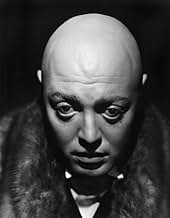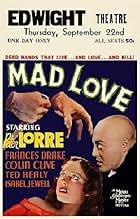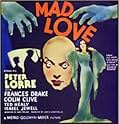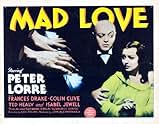IMDb RATING
7.2/10
6.2K
YOUR RATING
In Paris, a demented surgeon's obsession with a British actress leads him to secretly replace her concert-pianist husband's mangled hands with those of a guillotined murderer with a gift for... Read allIn Paris, a demented surgeon's obsession with a British actress leads him to secretly replace her concert-pianist husband's mangled hands with those of a guillotined murderer with a gift for knife-throwing.In Paris, a demented surgeon's obsession with a British actress leads him to secretly replace her concert-pianist husband's mangled hands with those of a guillotined murderer with a gift for knife-throwing.
- Awards
- 1 nomination total
Sara Haden
- Marie
- (as Sarah Haden)
George Davis
- Chauffeur
- (scenes deleted)
Billy Dooley
- Undetermined Role
- (scenes deleted)
Harold Huber
- Thief
- (scenes deleted)
Isabel Jewell
- Marianne
- (scenes deleted)
Leo White
- Undetermined Role
- (scenes deleted)
Sam Ash
- Detective Arresting Stephen
- (uncredited)
Hooper Atchley
- Train Conductor
- (uncredited)
Agostino Borgato
- Stage Doorman
- (uncredited)
Maurice Brierre
- Taxi Driver
- (uncredited)
Featured reviews
When acclaimed concert pianist Stephen Orlac (Colin Clive) is in a terrible accident, his hands are crushed and must be amputated. His wife Yvonne (Frances Drake) appeals to the brilliant Dr. Gogol (Peter Lorre) to use his surgical genius to save Stephen's hands. Gogol accepts as he's madly in love with Yvonne, but instead of saving Stephen's hands, he replaces them with those from an executed murderer.
This was Lorre's first American film, and one of his very best performances ever. He's at once menacingly creepy and pathetically sympathetic, a brilliant mind trapped in an ugly body, deeply in love with someone he can never have. I also really like Drake as the object of affection, beautiful, classy and empathetic. Lorre's costume late in the film is a visual highlight of 1930's film, and the moody cinematography is excellent. Recommended.
This was Lorre's first American film, and one of his very best performances ever. He's at once menacingly creepy and pathetically sympathetic, a brilliant mind trapped in an ugly body, deeply in love with someone he can never have. I also really like Drake as the object of affection, beautiful, classy and empathetic. Lorre's costume late in the film is a visual highlight of 1930's film, and the moody cinematography is excellent. Recommended.
Excellent, morbid story of a brilliant sureon's (Lorre) obsessive, fetishistic love for a Grand Guignol style actress. The early scenes are perhaps the best film evocative of actual Grand Guignol sadefests. Lorre manages to procure a perfect waxen statue of his love object, thus introducing doppleganger horror, a relatively rare treat in American horror. The main plot focuses on Lorre's attempt to implicate Drake's husband in a series of murders by convincing him that the hands he grafted for him are acting of their own will (as in "Hands of Orlac"). Many subtle moments (which critics have not credited the film for), some garishly out-of-place slapstick humor is the only negative aspect. Fantastic photography.
This is Lorre's entry into classic horror stardom: Karloff has his Frankenstein monster, Lugosi has Dracula (forever, folks), Chaney Jr. has the wolfman, and Lorre's got this lesser-known but equally classic film to recommend him as one of the major horror stars of the classic era. This film represents MGM's entry into the early 30s horror film sweepstakes as well, and they did well to associate themselves with solid hands like Freund's and Lorre's. Hands..... hmmmmm unintended pun. Anyway, if anyone out there is a fan of classic horror films and has not yet seen this one, put it at the top of your list.
This is Lorre's entry into classic horror stardom: Karloff has his Frankenstein monster, Lugosi has Dracula (forever, folks), Chaney Jr. has the wolfman, and Lorre's got this lesser-known but equally classic film to recommend him as one of the major horror stars of the classic era. This film represents MGM's entry into the early 30s horror film sweepstakes as well, and they did well to associate themselves with solid hands like Freund's and Lorre's. Hands..... hmmmmm unintended pun. Anyway, if anyone out there is a fan of classic horror films and has not yet seen this one, put it at the top of your list.
Brilliant surgeon Dr. Gogol is infatuated with Horror Theatre star Yvonne Orlac. After meeting her in person and realising that she only has eyes for her husband, the renowned pianist Stephen Orlac, he buys a life size mannequin of her and dreams of doing what Pygmalion did with Galatea. When Stephen is involved in an horrific train crash and has both his hands crushed beyond healing, Yvonne pleads with Gogol to help save his well being, he does, by amputating the crushed hands and grafting on the hands of a recently executed murderer, a murderer whose speciality was knives!
Mad Love is one of those amazingly old classics that is a hybrid of genre staples. At times it's surrealist and at others it's operating via a Grand Guginol pulse, whilst knowingly it laces the story with an uneasy comedic bent. Boasting camera work from Gregg Toland and Chester Lyons and directed by the impressive Karl Freund, this adaptation of Maurice Renard's novel is a chillingly memorable piece of work. Working off a plot that sees the bad Doctor driven by lustations rather than out and out insanity, Freund revels in slowly winding the coil until the spring that is Peter Lorre (Gogol) explodes (implodes), cloaking various scenes in telling shadows that themselves become integral to the plot. Peter Lorre is of course in his element, demented yet sympathetic, it's real hard to take your eyes away from his magnetic weirdness. Colin Clive as Stephen Orlac also puts in a performance of note, all twitchy nervousness and believable emotional torment, whilst Frances Drake more than adequately brings vulnerability to the centrifugal importance of Yvonne's emotional turmoil.
Weird and gorgeous, and incredibly well written, Mad Love holds up very well today as a horror/romance film of vast influential worth. So see it in the dark and marvel at its various moments of cinematic excellence. 8.5/10
Mad Love is one of those amazingly old classics that is a hybrid of genre staples. At times it's surrealist and at others it's operating via a Grand Guginol pulse, whilst knowingly it laces the story with an uneasy comedic bent. Boasting camera work from Gregg Toland and Chester Lyons and directed by the impressive Karl Freund, this adaptation of Maurice Renard's novel is a chillingly memorable piece of work. Working off a plot that sees the bad Doctor driven by lustations rather than out and out insanity, Freund revels in slowly winding the coil until the spring that is Peter Lorre (Gogol) explodes (implodes), cloaking various scenes in telling shadows that themselves become integral to the plot. Peter Lorre is of course in his element, demented yet sympathetic, it's real hard to take your eyes away from his magnetic weirdness. Colin Clive as Stephen Orlac also puts in a performance of note, all twitchy nervousness and believable emotional torment, whilst Frances Drake more than adequately brings vulnerability to the centrifugal importance of Yvonne's emotional turmoil.
Weird and gorgeous, and incredibly well written, Mad Love holds up very well today as a horror/romance film of vast influential worth. So see it in the dark and marvel at its various moments of cinematic excellence. 8.5/10
Dr. Gogol (Peter Lorre) is a brilliant surgeon who is obsessed with actress Yvonne Orlac (Francis Drake). She tells him she is leaving the stage to be a full time wife to her husband Stephen Orlac (Colin Clive), a concert pianist. Gogol is crushed. Stephen Orlac loses his hands in a train wreck.
At the request of Yvonne, Orlac grafts on a new pair of hands to Stephen. Unfortunately, they happen to be the hands of Rollo, an executed murderer who loved throwing knives. It seems the hands have a life of their own--Stephen can't play the piano anymore but can throw knives accurately and he has a desire to kill. He slowly starts to go crazy. Gogol again tells Yvonne that he loves her. She rejects him and Gogol cracks. He sets out to drive Stephen mad--and drive Yvonne into his arms.
The plot is silly but it still works. Anyways, the film isn't respected for its plot--it's because of Lorre and the sets. The sets in this film are huge, designed very strangely and add to the weirdness of the plot. They're all dimly lit giving the film a dark, depressing look. The acting is almost all good. Drake is just beautiful and perfect as the suffering wife. Clive is way too serious and looks horrible--sadly the man suffered from alcoholism...and it shows. Lorre is just superb as Gogol. He's very severe looking with his shaved head. You see him start out as kindly but obsessed and slowly slip into madness. Also there's a genuinely terrifying meeting Orlac has with Gogol (disguised as someone else) in a hotel. And director Karl Fruend throws in an amusing in joke--someone's repeats the "It went for a little walk" line from his "The Mummy" (1932)! The only real debit is the unnecessary "comic" relief from Ted Healy and an alcoholic landlady (sorry, but alcoholism isn't funny).
This is still mostly unknown more than 60 years after its release. Why? It bombed badly when it came out, was too grim for most people and it almost never pops up on TV. That's a shame--it's one of the best horror films to come out in the 1930s. See this if you get a chance--it's only 70 minutes and it's well worth it! One of Lorre's best performances.
At the request of Yvonne, Orlac grafts on a new pair of hands to Stephen. Unfortunately, they happen to be the hands of Rollo, an executed murderer who loved throwing knives. It seems the hands have a life of their own--Stephen can't play the piano anymore but can throw knives accurately and he has a desire to kill. He slowly starts to go crazy. Gogol again tells Yvonne that he loves her. She rejects him and Gogol cracks. He sets out to drive Stephen mad--and drive Yvonne into his arms.
The plot is silly but it still works. Anyways, the film isn't respected for its plot--it's because of Lorre and the sets. The sets in this film are huge, designed very strangely and add to the weirdness of the plot. They're all dimly lit giving the film a dark, depressing look. The acting is almost all good. Drake is just beautiful and perfect as the suffering wife. Clive is way too serious and looks horrible--sadly the man suffered from alcoholism...and it shows. Lorre is just superb as Gogol. He's very severe looking with his shaved head. You see him start out as kindly but obsessed and slowly slip into madness. Also there's a genuinely terrifying meeting Orlac has with Gogol (disguised as someone else) in a hotel. And director Karl Fruend throws in an amusing in joke--someone's repeats the "It went for a little walk" line from his "The Mummy" (1932)! The only real debit is the unnecessary "comic" relief from Ted Healy and an alcoholic landlady (sorry, but alcoholism isn't funny).
This is still mostly unknown more than 60 years after its release. Why? It bombed badly when it came out, was too grim for most people and it almost never pops up on TV. That's a shame--it's one of the best horror films to come out in the 1930s. See this if you get a chance--it's only 70 minutes and it's well worth it! One of Lorre's best performances.
10Gafke
Apparently, Peter Lorre only agreed to do this film because he had been promised the lead in "Crime & Punishment" afterwards if he did it. I've seen both films, and though Lorre was magnificent in both, I prefer this one. I'm so glad he agreed to do it.
"Mad Love" is the story of Doctor Gogol, brilliant Parisian surgeon whose reputation for doing surgeries on desperate cases free of charge is well- renowned. But Doctor Gogol is a morbid man as well, gleefully attending public beheadings and taking orgasmic delight in the Grand Guignol Theatre de Horreur, which stages realistic horror plays. The star of the Theatre is Yvonne, and Doctor Gogol is madly in love with her, hence the title of our film. But Yvonne is already married to Stephen Orlac, a famous concert pianist. Doctor Gogol, with his bald head and buggy eyes, gives her the creeps and her distaste for him is clear. However, when her husbands train crashes and his million-dollar hands are destroyed, it is Doctor Gogol she turns to. Desperate to win the love of Yvonne, Gogol agrees to do the impossible. Stephen Orlac is saved...but only Gogol knows that his hands are no longer his own. They once belonged to a killer, and they want to kill again.
Lorre turns in yet another astonishing performance here; his Gogol is very convincing, quite capable of handling a few lines of cornball dialogue without seeming foolish in the least. And the sympathy he elicits is simply amazing; I found myself cheering for him the whole time instead of for Yvonne, who struck me as a cold, opportunistic gold digger, quite willing to use the Doctor if it served her purpose. I'm sure this was not the intent of the filmmakers, but Lorre emerges as the hero here, at least in my humble opinion. Toward the end of the film, he is completely unleashed, playing mad, wild music on the organ and donning a most hideous metal contraption which looks like something that H. R. Giger might have designed.
This beautiful black-and-white film by MGM rivals the classic monsters of Universal, and placed Peter Lorre alongside such horror movie icons as Bela Lugosi, Boris Karloff and Vincent Price. Reportedly, Lorre detested these horror film roles that made him famous, but his resentment never shows through; he threw himself into this and every role with creativity and zeal. He is truly marvelous to watch. Mad Love should not be missed by fans of old, spooky Gothic tales. It is a masterpiece.
"Mad Love" is the story of Doctor Gogol, brilliant Parisian surgeon whose reputation for doing surgeries on desperate cases free of charge is well- renowned. But Doctor Gogol is a morbid man as well, gleefully attending public beheadings and taking orgasmic delight in the Grand Guignol Theatre de Horreur, which stages realistic horror plays. The star of the Theatre is Yvonne, and Doctor Gogol is madly in love with her, hence the title of our film. But Yvonne is already married to Stephen Orlac, a famous concert pianist. Doctor Gogol, with his bald head and buggy eyes, gives her the creeps and her distaste for him is clear. However, when her husbands train crashes and his million-dollar hands are destroyed, it is Doctor Gogol she turns to. Desperate to win the love of Yvonne, Gogol agrees to do the impossible. Stephen Orlac is saved...but only Gogol knows that his hands are no longer his own. They once belonged to a killer, and they want to kill again.
Lorre turns in yet another astonishing performance here; his Gogol is very convincing, quite capable of handling a few lines of cornball dialogue without seeming foolish in the least. And the sympathy he elicits is simply amazing; I found myself cheering for him the whole time instead of for Yvonne, who struck me as a cold, opportunistic gold digger, quite willing to use the Doctor if it served her purpose. I'm sure this was not the intent of the filmmakers, but Lorre emerges as the hero here, at least in my humble opinion. Toward the end of the film, he is completely unleashed, playing mad, wild music on the organ and donning a most hideous metal contraption which looks like something that H. R. Giger might have designed.
This beautiful black-and-white film by MGM rivals the classic monsters of Universal, and placed Peter Lorre alongside such horror movie icons as Bela Lugosi, Boris Karloff and Vincent Price. Reportedly, Lorre detested these horror film roles that made him famous, but his resentment never shows through; he threw himself into this and every role with creativity and zeal. He is truly marvelous to watch. Mad Love should not be missed by fans of old, spooky Gothic tales. It is a masterpiece.
Did you know
- TriviaCharles Chaplin called Lorre the screen's best actor after seeing his performance in "Mad Love."
- GoofsThroughout the picture, the wax figure moves slightly whenever Frances Drake is subbing for the actual statue. Most noticeable when the bird lands on her shoulder, making the "lifeless" statue sway.
- Quotes
Françoise, Gogol's Housekeeper: [referring to the wax figure of Yvonne] It went out for a little walk!
- Crazy creditsAt the end of the opening credits, the titles are painted on a glass window pane that is broken by a fist punching through it.
- Alternate versionsPhil Hardy's The Overlook Film Encyclopedia: Science Fiction (p. 94) states that there is an 85-minute version of the film, although he provides no details about this.
- ConnectionsEdited into The History of the Hands (2016)
- How long is Mad Love?Powered by Alexa
Details
- Release date
- Country of origin
- Language
- Also known as
- Mad love, les mains d'Orlac
- Filming locations
- Production company
- See more company credits at IMDbPro
Box office
- Budget
- $257,502 (estimated)
- Runtime1 hour 8 minutes
- Color
- Aspect ratio
- 1.37 : 1
Contribute to this page
Suggest an edit or add missing content




